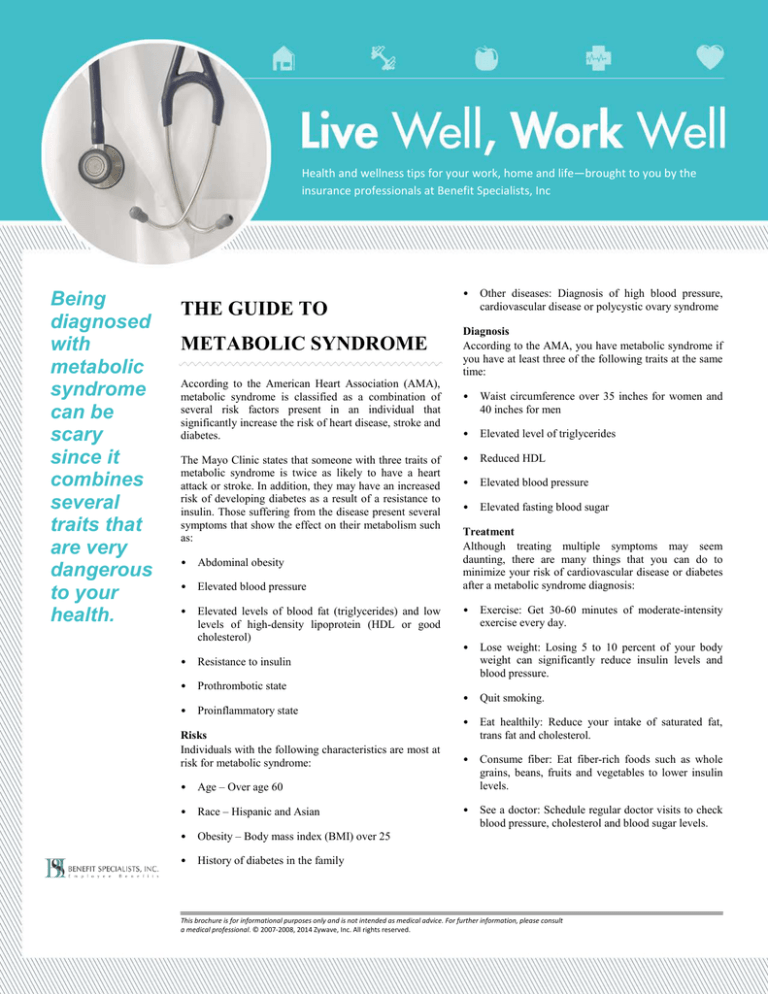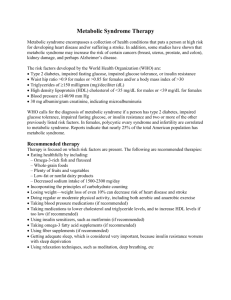
Health and wellness tips for your work, home and life—brought to you by the
insurance professionals at Benefit Specialists, Inc
Being
diagnosed
with
metabolic
syndrome
can be
scary
since it
combines
several
traits that
are very
dangerous
to your
health.
•
THE GUIDE TO
METABOLIC SYNDROME
According to the American Heart Association (AMA),
metabolic syndrome is classified as a combination of
several risk factors present in an individual that
significantly increase the risk of heart disease, stroke and
diabetes.
The Mayo Clinic states that someone with three traits of
metabolic syndrome is twice as likely to have a heart
attack or stroke. In addition, they may have an increased
risk of developing diabetes as a result of a resistance to
insulin. Those suffering from the disease present several
symptoms that show the effect on their metabolism such
as:
•
Abdominal obesity
•
Elevated blood pressure
•
Elevated levels of blood fat (triglycerides) and low
levels of high-density lipoprotein (HDL or good
cholesterol)
•
Resistance to insulin
•
Prothrombotic state
•
Proinflammatory state
Risks
Individuals with the following characteristics are most at
risk for metabolic syndrome:
•
Age – Over age 60
•
Race – Hispanic and Asian
•
Obesity – Body mass index (BMI) over 25
•
History of diabetes in the family
Other diseases: Diagnosis of high blood pressure,
cardiovascular disease or polycystic ovary syndrome
Diagnosis
According to the AMA, you have metabolic syndrome if
you have at least three of the following traits at the same
time:
•
Waist circumference over 35 inches for women and
40 inches for men
•
Elevated level of triglycerides
•
Reduced HDL
•
Elevated blood pressure
•
Elevated fasting blood sugar
Treatment
Although treating multiple symptoms may seem
daunting, there are many things that you can do to
minimize your risk of cardiovascular disease or diabetes
after a metabolic syndrome diagnosis:
•
Exercise: Get 30-60 minutes of moderate-intensity
exercise every day.
•
Lose weight: Losing 5 to 10 percent of your body
weight can significantly reduce insulin levels and
blood pressure.
•
Quit smoking.
•
Eat healthily: Reduce your intake of saturated fat,
trans fat and cholesterol.
•
Consume fiber: Eat fiber-rich foods such as whole
grains, beans, fruits and vegetables to lower insulin
levels.
•
See a doctor: Schedule regular doctor visits to check
blood pressure, cholesterol and blood sugar levels.
This brochure is for informational purposes only and is not intended as medical advice. For further information, please consult
a medical professional. © 2007-2008, 2014 Zywave, Inc. All rights reserved.








